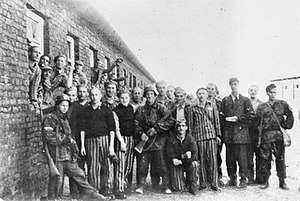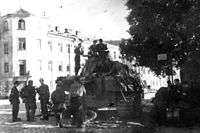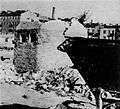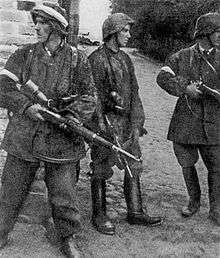Gęsiówka
Gęsiówka (Polish pronunciation: [ɡɛ̃ˈɕufka]) is the colloquial Polish name for a prison that once existed on Gęsia ("Goose") Street in Warsaw, Poland, and which, under German occupation during World War II, became a Nazi concentration camp.

In 1945–56 the Gęsiówka served as a prison and labor camp, operated first by the Soviet NKVD to imprison Polish resistance fighters of the Home Army and other opponents of Poland's new Stalinist regime, then by the Polish communist secret police.
History
Before the war, Gęsiówka was a military prison of the Polish Army on Gęsia Street (now Anielewicza Street), near the intersection with Okopowa Street and the Jewish cemetery. Beginning in 1939, after the German occupation of Poland, it became a re-education camp of the German security police (Arbeitserziehungslager der Sicherheitspolizei Warschau).
In 1943, the prison was turned into a concentration camp for mostly Jewish inmates from countries other than Poland, Greece and Hungary in particular. The camp, known as the Warsaw concentration camp, housed, over the course of its operation, an estimated 8,000–9,000 prisoners, who were engaged in slave labour. 4,000 to 5,000 are estimated to have died in the camp, during the death march from the camp, the Warsaw Uprising, and hiding after the uprising.[1]
Currently in the place of now former Gęsiówka prison, there's a Polish Jews' history museum honoring all the Jews that died from a German hand in that camp.[2]
Liberation during Warsaw Uprising


On 5 August 1944, early in the Warsaw Uprising, the "Zośka" scouting battalion of the Home Army's Radosław Group, led by Ryszard Białous and Eugeniusz Stasiecki, attacked the Gęsiówka camp, which was being liquidated by the Germans. Magda, one of two Panther tanks that had been captured by Polish insurgents on 2 August, and assigned to Zośka's newly formed armour platoon commanded by Wacław Micuta,[3] supported the assault with fire from its main gun. In the one-and-a-half-hour battle, most of the SD guards were killed or captured, though some fled toward the Pawiak prison.
Only two Polish fighters were killed in the attack. Rescued from certain death were 348 able-bodied Jewish prisoners who had been retained by the Germans as slave labour after the Germans' 1943 liquidation of the Warsaw Ghetto and had been left behind after the evacuation of most of the Gęsiówka camp's inmates in July 1944.[4][5]
Many of the Jewish prisoners joined the ranks of the insurgents, and most were killed in the next nine weeks of fighting, as were most of their liberators (the "Zośka" battalion lost 70% of its members in the Uprising).[6]
After World War II
In January 1945 Gęsiówka was used by the Soviet NKVD to imprison Polish resistance fighters of the Home Army and other opponents of Poland's new Stalinist regime, who were kept there in appalling conditions. The Polish communist secret police took over the administration of the camp later that year and continued to use it as a prison and labour camp for criminal and political prisoners, including so-called "class enemies", until 1956.[7]
Gęsiówka liberation memorial
Gęsiówka was demolished in the 1960s and the only visible evidence of its existence today is a memorial plaque commemorating the liberation of the camp in 1944, which is on the wall of 34 Anielewicza Street.[8]
The memorial was unveiled during the commemoration of the fiftieth anniversary of the Warsaw Uprising in 1994. Wacław Micuta, commander of the armoured platoon of the Zośka battalion, said the following words at the ceremony:
On 27th July the Germans decided to evacuate the Gęsiówka camp to Dachau. More than 400 inmates, incapable of marching, were shot....A column of about 4,000 Jews was marched off, but disappeared without trace. And now the Zośka battalion was standing in front of this camp. They remembered the Scouting Statute, which says that a scout is a friend to every other human being and a brother to every other scout. We all wanted to attack immediately....and since we had captured a couple of tanks, the situation was rather better than in the previous days. So four of us went back to "Radosław" [Jan Mazurkiewicz, commander of the insurgent forces in Warsaw's Wola district] to ask for permission. Radosław was a cautious man and shared the view that the fortified positions should not be attacked frontally. But he agreed on condition that the attacking force be small in number and be composed entirely of volunteers....We carried it off by surprise. Our tank was a great success because the Germans [in the camp] had no anti-tank weapons. After the main gateway was destroyed Felek's platoon moved in....[9]
The memorial features inscriptions in Polish, Hebrew and English.
Gallery
.jpg) Polish resistance fighters from the "Giewont" company of the "Zośka" battalion secure Gęsiówka after the liberation (5 August 1944)
Polish resistance fighters from the "Giewont" company of the "Zośka" battalion secure Gęsiówka after the liberation (5 August 1944).jpg) Gęsiówka after the liberation - in the picture, a Polish resistance fighter and two of the 348 liberated Jews (5 August 1944)
Gęsiówka after the liberation - in the picture, a Polish resistance fighter and two of the 348 liberated Jews (5 August 1944) Three Polish resistance fighters pictured after liberating the "Gęsiówka” concentration camp - from left to right: an unknown insurgent, Stanisław Kozicki (code name "Howerla") and Wacław Cyniak (code name "Orlicz")
Three Polish resistance fighters pictured after liberating the "Gęsiówka” concentration camp - from left to right: an unknown insurgent, Stanisław Kozicki (code name "Howerla") and Wacław Cyniak (code name "Orlicz") Polish resistance fighters from the "Giewont" company of the "Zośka" battalion secure Gęsiówka after the liberation. The crematorium building is visible in the background
Polish resistance fighters from the "Giewont" company of the "Zośka" battalion secure Gęsiówka after the liberation. The crematorium building is visible in the background Polish resistance fighters in the Gęsiówka watchtower after the liberation
Polish resistance fighters in the Gęsiówka watchtower after the liberation Liberated Jewish prisoners - one wearing a German Stahlhelm - smiling for the camera
Liberated Jewish prisoners - one wearing a German Stahlhelm - smiling for the camera Gęsiówka bunker destroyed by soldiers of the "Zośka" battalion
Gęsiówka bunker destroyed by soldiers of the "Zośka" battalion Three Polish resistance fighters pictured after liberating the "Gęsiówka" concentration camp - from left to right: Wojciech Omyła (code name “Wojtek"), Juliusz Bogdan Deczkowski (code name “Laudański") and Tadeusz Milewski (code name "Ćwik")
Three Polish resistance fighters pictured after liberating the "Gęsiówka" concentration camp - from left to right: Wojciech Omyła (code name “Wojtek"), Juliusz Bogdan Deczkowski (code name “Laudański") and Tadeusz Milewski (code name "Ćwik")
See also
References
- The United States Holocaust Memorial Museum Encyclopedia of Camps and Ghettos, 1933–1945, Geoffrey P. Megargee, Martin Dean, and Mel Hecker, Volume I, part B, pages 1512–1515
- Kopka 2007, p. 117
- Odznaczenie dla Wacława Micuty, Prezydent RP, 2007-04-10 Archived 23 May 2006 at the Wayback Machine
- http://www.warsawtour.pl/en/warsaw-for-everyone/judaica-1863.html?page=0,3
- Wojciech Rostafinski. How the Last Jews in Warsaw Were Saved. Courtesy of Heralds of Truth, Michigan.
- Stefan Korbonski The Polish Underground State: A Guide to the Underground, 1939-1945 Archived 27 September 2011 at the Wayback Machine
- Obóz koncentracyjny na terenie ruin getta warszawskiego („Gęsiówka") - in Polish
- "Archived copy". Archived from the original on 24 September 2015. Retrieved 13 April 2015.CS1 maint: archived copy as title (link)
- Norman Davies, Rising '44: The Battle for Warsaw, Pan Books 2004 pp609-610